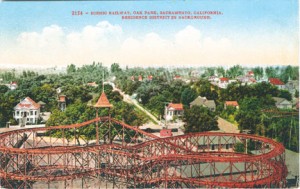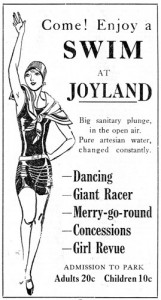Joyland
Posted on February 1, 2010 – 10:20 AM | by OldManFosterBy Niki Kangas Images courtesy the Sacramento Room
Let’s go back a little over a hundred years to a time when Oak Park was in its beginnings- a new neighborhood adjacent to the hustle and bustle of post-Gold Rush Sacramento. The emergence of trolleys enabled city laborers to make quick work of the daily commute and also enabled the sale of previously less enticing land parcels; Oak Park was born as Sacramento’s first working class “suburb.”
Flourishing in the middle of what is now McClatchy Park once stood a now all but forgotten amusement park, filled with the laughter of throngs of people now mostly reduced to ghosts. Few are left today who remember Oak Park’s Joyland in all its glory. The immense front gate beckoned from what is now the intersection of 35th St. and 5th Ave- the site of one of Oak Park’s post offices today- and one streetcar line ended and turned back toward town, there beneath its bulk.
Amusement parks, like the trolleys, were tried and true lures for potential property purchases at that time. New York erected Coney Island for this purpose; Los Angeles had the Santa Monica Pier. A group of investors called the Central Street Railway Company introduced four streetcar lines connecting the city center to the outlying neighborhoods. The initial technology was pretty lame, but the lines thrived once overhead electric trolley lines were substituted. In 1894, they plotted an eight-acre pleasure ground nestled in an ancient grove of oaks on Doyle’s ranch, thereby christening the new neighborhood “Oak Park”.
Illuminated by lights- provided by a newly erected electric plant- and housing a pavilion for concerts, a concession stand, and a dance floor, Oak Park would be a family resort devoid of liquor sales so that, as planned by the investors, “parents with their children may feel perfectly safe riding out upon the cars of the company and spending a day or evening.” By 1895, a ballpark, a small zoo and a carousel were added to the list of amusements. Eight years later, the streetcar company was restructured as the Sacramento Gas, Electric and Railway Company, which outsourced management of the park grounds to a franchise amusement operator that annexed an outdoor theater for vaudeville acts and began showing “the flickers” (later referred to as “movies”). In short order they added a rollerskating rink, a miniature scenic railway, a cave of winds, and a roller coaster. The holiday crowd at summer’s end on Labor Day of 1903 was reported to total 20,000 people.
 As the park thrived, so did the neighborhood. Oak Park saw a steady influx of new businesses and residences, most of which were affordably priced to be accessible to the working class. Oak Park, always a multi-racial community, had already developed its strong community identity by 1911, when it was incorporated into the city of Sacramento.
As the park thrived, so did the neighborhood. Oak Park saw a steady influx of new businesses and residences, most of which were affordably priced to be accessible to the working class. Oak Park, always a multi-racial community, had already developed its strong community identity by 1911, when it was incorporated into the city of Sacramento.
The management of the park again changed hands in 1913, with the Ingersoll family now in charge. At this point, PG&E, who had grown tired of holding the deed, wanted to subdivide the property and parcel it off. The Ingersolls implemented changes to save the park- a swimming pool and perimeter fence were built, and the park was renamed “Joyland.” On Joyland’s Grand Opening day, 10,000 people turned out to purchase a ticket. Prior to this, admission had been free, but now with PG&E getting a piece of the pie, they were happy to let the Ingersolls continue to run the park. The business district of Oak Park blossomed under the shadow of the roller coaster, and for the next several years trolleys carried patrons by the thousands to Joyland on summer weekends.
Tragedy struck in 1920 when fire swallowed much of the park. After such a hit, Joyland never got her groove back, largely due to the concurrent development of glossier venues around the region and the arrival of the automobile, which changed patterns of work and recreation. As the park declined and other neighborhoods arose, property values in the area began to drop. The heyday of Joyland was over.
In 1927, Mr. and Mrs. Valentine McClatchy bought up the acreage of Joyland’s remnants, gifting the grounds to the city on the condition they name it “James McClatchy Park” after Valentine’s father, the founding editor of the Sacramento Bee. Today, McClatchy Park plays host to an Urban Farmstand (see sidebar), a swimming pool, a playground, tennis courts, basketball courts, an auditorium and a library. And though there is no rollercoaster ride, no scenic railway or Cave of Winds, there is still fresh air and green grass, and sometimes, among those not yet reduced to ghosts, stories of the place that used to be.
Tags: JoyLand, McClatchy Park, Niki Kangas, Oak Park, Sacramento


